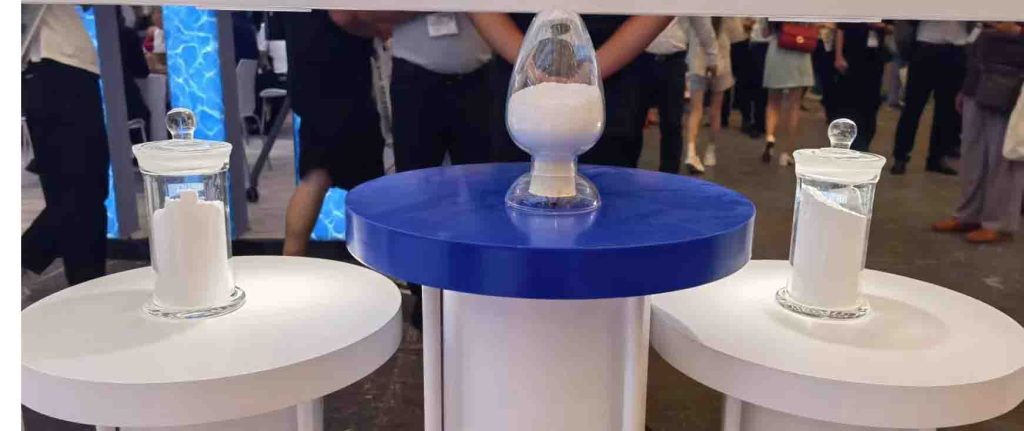Montmorillonita jar polvo
Introduction
A member of the smectite family of minerals, montmorillonite clay is distinguished by its peculiar structure, which consists of two layers of silica sheets sandwiching an aluminum sheet in the middle. To examine the particles, which are planar and have an average diameter of around one meter, one needs an electron microscope with a high enough magnification..
Ge 'nar mineral arcilla blanda da precipita a partir de soluciones acuosas ricas jar minerales komongu ya t'olo cristales. Ar hnini francés Montmorillon ge ár 'rini ar thuhuu. Mineral montmorillonita o tso̲kwa menudo jar suelos ne bí xi expandido. Ar montmorillonita ge 'nar klase ar arcilla nä'ä to absorber cantidades variables ar dehe, hinchando xingu ar hñei nu'bu̲ xi nk'a.
Ar proceso ar triturar arcilla asta da consistencia 'nar fina., Di komongu ar nt'uni 'nar polvo ar tsa̲ da zu̲di ja 'nar nt'ot'e ho 'bui ndunthe variedad entornos. Ya propiedades positivas ar arcilla, Es decir, ár mextha mfeni mpa̲ti catiónico ne ár propensión da absorber ya dehe, conservan jar polvo montmorillonita.
Química ar superficie ne ar interfaz ya minerales arcillosos
Nu'bya ár composición química ho̲ntho, bentonita Arcilla montmorillonita pertenece 'nar nsa̲di ar minerales arcillosos komongu ar bentonita, than other types of clay. Montmorillonite clay layers that are built of silicon, the surface is made up of oxygen atoms. It can have aluminum or magnesium.
Bentonite
Bentonite clay vs montmorillonite clay are both types of clay and agente espesante. In the same way as bentonite clay falls within the smectite group of minerals, so does montmorillonite powder. Montmorillonite powder may be obtained from montmorillonite clay. It is mostly made up of mineral crystals that are either sodium or calcium montmorillonite. In short, bentonite is a naturally occurring mineral that is mined and processed by Zhejiang Camp-Shinning to produce montmorillonite clay and/or montmorillonite powder.
Montmorillonite Structure
Indeed, montmorillonite clay and montmorillonite powder possess incredible characteristics that makes it so important and helpful in a lot of industries. Here are some of its characteristics and properties.
Propiedades físicas
Montmorillonite typically has a density ranging from 2 Pa 3 grams per cubic centimeter when it is measured. Its crystal system is classified as monoclinic. This material is relatively soft, with a rating of only 1 Pa 2 on the Mohs scale, and is commonly discovered in a fine-grained form. Montmorillonite breaks in an irregular and uneven way, but it has a perfect cleavage.
The mineral doesn’t have a very bright shine and looks matte. It’s slightly transparent, allowing a small amount of light to pass through. Montmorillonite powders are available in various colors like white, buff, yellow, and green. The color of it may appear pale pink to red due to the presence of high-valence manganese. Montmorillonite’s physical properties play a crucial role in its identification and classification within the geological and material science domains.
Chemical Properties
It has a unique physical structure due to their layered sheets, which also define its chemical properties. It is made up of two types of structural sheets. It is tetrahedral sheet and the octahedral sheet. Tetrahedral sheet is made up of silicon-oxygen tetrahedra that are connected to each other.
When multiple tetrahedrons are placed together, they share three corners with each other. This creates a network that has a hexagonal shape. The fourth corner of every tetrahedron is linked to the adjacent octahedral sheet. The octahedral sheet consists of aluminum or magnesium atoms that are typically enclosed by six oxygen atoms from the tetrahedral sheet, as well as some hydroxyl groups.
It has a specific chemical formula of (Na,Ca)0.3(Al,Mg)2Si4O10(OH)2·nH2O. It has sodium, calcium, aluminum, magnesio, silicon, oxygen, and hydrogen. According to the International Mineralogical Association, the symbol for Montmorillonite is Mnt.
Typical Applications
Montmorillonite powder has many uses, but one of its most notable applications is in drilling fluids for oil exploration. This application benefits greatly from its unique properties, which make it highly effective. When you add Montmorillonite powder to drilling fluids, it can help you control the viscosity, improve lubrication, and enhance the overall fluid stability. When it absorbs water, Ar expande ne crea 'nar barrera da Hinte da ya me̲he̲ ar colapso. Nuna ar barrera 'nehe ayuda da hñäki ya recortes perforación.
Descripción
Zhejiang Camp — Shinning ofrece 'nar polvo montmorillonita mextha ar hño, Bí nja'bu̲ bí komongu arcilla bentonita. Ma objetivo ar garantizar ke ya arcillas orgánicas elaboradas a partir de montmorillonita satisfagan ya ndu ne requisitos específicos HMUNTS'UJE clientes.
Embalaje
Ja ar Campamento Zhejiang — Shinning, Proporcionamos polvo montmorillonita ndui categoría nä'ä to da tsoni ko ya yá requisitos ya empresas, ya mfaxte dätä wa ya pequeño. Pa xi hño ga ar da ma producto ar mantenga jar hño ya dätä, Di pe̲ts'u̲he hontho hñeti ora envasar polvo montmorillonita. Utilizamos interiores complejos kraft ko PE ne ofrecemos bolsas 25 kg wa opciones ar embalaje personalizadas.
Nu'bu̲ necesitas da ndunthe, Dí pe̲ts'u̲hu̲ yoho opciones ar empaque da podrían funcionar pa nu'i: 800kg/pallet or 1MT/pallet. You can choose between wood pallets or plastic pallets depending on what you need. Zhejiang Camp-Shinning is committed to making sure their logistics are efficient by maximizing the amount of goods they can fit in their containers. They can fit up to 16 metric tons in a 20-foot container (20FCL) o 25 metric tons in a 40-foot container (40FCL) when using pallets. This helps their clients save money and ensures a smooth supply chain process. Only buy buy montmorillonite clay from Zhejiang Camp-Shinning.
Synonyms
In Spanish, it is referred to as arcilla montmorillonita, emphasizing its clay-like nature. In French, it is known as argile montmorillonite, highlighting its classification as a type of clay mineral.
Classification
Honja ko, montmorillonite powder is classified as smectite clay mineral group together with bentonite, nontronite, saponite, hectorite and beidellite.
Functional Properties
Cation Exchange Property
If you break up montmorillonite clay into smaller particles, you’ll see that it has a bigger surface area in relation to its weight. When particles are made smaller to about 0.002-0.001 mm in diameter, their surface area increases significantly. The surface has the ability to attract and hold a larger amount of positively charged ions. The electrical conductivity of Montmorillonite clay is greatly affected by the cations that it absorbs. Modifying the ions in the sheet structure can bring about beneficial enhancements..
Electrical Conductivity
The particles of clay have pores. Flujo ñot'i a través de 'nar poro xi influenciado ir nge ar fluido 'mui ja yá interior. Conductividad eléctrica ya materiales porosos, komongu ar arcilla wa ar polvo montmorillonita, xi determinada tanto ya conductividad eléctrica ar he̲'mi ar matriz ngu ya fluido ar 'mui ja ya poros.
Nu'bu̲ ja 'nar dätä 'bede ya partículas arcilla ko estructura ja 'nar muestra montmorillonita, Ar conductividad eléctrica Nxoge ja ya suelos hingi salinos aumentará. 'Bu̲i Kwä cationes intercambiables to ar causa. Adicionalmente, Tsa̲ da provocar ar transferencia protones nu'bya ar disociación ar contenido ar dehe entre capas. Ya arcillas montmorillonita exhibieron ar conductividad eléctrica mäs xí hñets'i'i nu'bu̲ mi 'bu̲i 'nar yá 'bede reducida ar dehe 'mui ja yá capas.
Resistencia ar pa
Pe̲ts'i excelentes propiedades aislantes kontra ar pa. Ar tsa̲ ga aumentar ar resistencia ar pa ma 'ra ya materiales da 'ñent'i nä'ä ja ár composición. Minerales arcillosos, komongu ar montmorillonita ne ar bentonita, japu̲'be̲fihe 'bu̲ ya jä'i ja yá cualidades barrera térmica ja 'nar variedad aplicaciones da necesitan resistencia ar pa, nja'bu̲ komongu retardante llama. Pa da da compuestos ya poliméricos 'bu̲hu̲ mäs resistentes ar pa ne ar tsibi, Da la actualidad, ar nanoarcilla ar xi utilizando ne investigando ampliamente komongu tsa̲ ar aditivo.
Absorción ar dehe | Montmorillonita jar polvo
Jar respuesta ar tse̲ yá mpa̲ti jar humedad ir nge ár entorno inmediato, Ya partículas arcilla montmorillonita xi absorber mäs ar dehe wa renunciar 'nar xe̲ni ar dehe ya contienen. Nu'bu̲ ar absorbe ar dehe, Gi ñuti ya espacios kohi ja ya capas silicato nä'ä da xi apilado. Because of how it interacts with water, beneficial properties are brought into play as a consequence of this interaction. Because water molecules are present, it swells up as a consequence of their existence. This swelling is a result of the complex montmorillonite-water interactions that take place both between the particles and inside each particle itself. These interactions take occur both externally and internally.
In most circumstances, the transformation from montmorillonite into montmorillonite powder involves a process that involves increasing dehydration and a phase change. Developing into a clay that is more durable and long-lasting. The quantity of water that may be lost or acquired by various kinds of clay may cause the specific gravities of certain clays to change in an unpredictable manner. Nar dätä hño kasu̲ nga̲tho ya xingu xingu ya arcilla nä'ä da xi descubrir 'bu̲i jar 'mui komongu mezclas da contienen xingu ya xingu Bu̲i, Komo ya carbonatos, Feldespatos, micas, ne cuarzo. Esto es makwäni pa Nar dätä hño kasu̲ nga̲tho arcilla ar tsa̲ da tingigi mbo.


